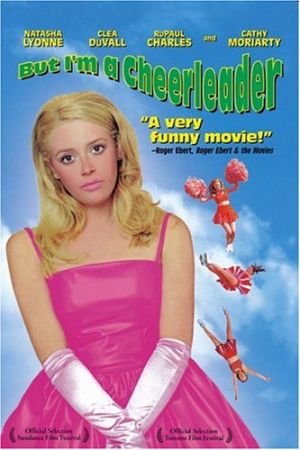
This guest post by Abeni Moreno appears as part of our theme week Representations of Female Sexual Desire.
But I’m a Cheerleader literally queers the stereotype of the popular cheerleader going steady with a handsome football player. Natasha Lyonne, who plays the main character, Megan, is confronted by friends and family who suspect her of being the “L” word. That’s right…a lesbian. Megan keeps provocative pictures of women in her locker, despises kissing her boyfriend and sexually fantasizes about her cheermates. It is then that she is sent off to a correctional program called “True Directions.”
But I’m a Cheerleader‘s overt display of oppression over queer sexuality speaks to the dominant patriarchal society that strives to eliminate all non-normative ways of living. In this case, the film focuses on Megan’s experience of discovering her queer sexuality ironically through her participation in “True Directions.” There she meets love interest Graham, Clea DuVull, who is portrayed as the bad girl with a trust fund. It is within their romantic involvement that the film makes painfully apparent conversation therapy fails miserably. Both characters find love and sexual desire in a place that is made to consist of homophobia, stereotypes, and internalized gender roles.

But I’m a Cheerleader exaggerates gender-“appropriate” color schemes throughout the film, presenting the audience with the ridiculousness of assigned gender roles that people are expected to embody throughout their lives. The Pepto Bismol pink and baby blue uniforms along with the decorated living quarters help illustrate the defined “normalcy” of gender and sexuality often forced upon people by our society. When Megan arrives at True Directions, she is unaware that her sexual fantasies about women and undesirable boyfriend are “abnormal.” The definition of normal is pushed even further when a more tender, intimate, and sensual love scene between Megan and Graham is highlighted as beautiful and loving. In comparison, Megan and her boyfriend are sloppy, awkward, and unaffectionate. But I’m a Cheerleader shows heterosexuality as mundane and unattractive. The film’s focus on a woman sexually desiring another woman is a creative protest of normative sexuality.
The film challenges other forms of gender/sexual expectations. For example, an androgynous character named Jan realizes she is heterosexual during a group therapy session. Her epiphany brings up a vital point that we should not pre-judge and categorize other people’s sexuality based on their gender, whether it be butch, feminine, trans*, etc. Jan states, “Everybody thinks I’m this big dyke because I wear baggy pants …play softball and I’m not as pretty as other girls, but that doesn’t make me gay… I like guys.. I can’t help it.” The other characters believe Jan is in denial because her outer appearance is masculine. Mike (RuPaul) even bluntly suggests, “Who is she trying to fool?” But I’m a Cheerleader uses Jan to comment on the way people label their peers and define their ways of love and sexuality for them even within the queer community.
Overall, But I’m a Cheerleader shows that there are few safe spaces for alternative sexuality and desire. The characters suppress their identities during their time at True Directions, showing how society often leaves little space for the queer community to be open and out. Megan and Graham hide their relationship, Sinead uses aversion therapy and Andre fails at being butch. These are all common obstacles that many people can relate to. Plus, the film’s 1950s nuance and decor displays the decade’s reputation for the nuclear family and cisgender children as commentary on a time where the majority of the queer community was not out and proud but underground. But I’m a Cheerleader makes it clear that we sometimes internalize discrimination and homophobia to try to fit in. But in the end, we can’t change who are or how we love no matter how much we try to drown ourselves in pink clothes and do our best to throw a football. It’s inevitable that we will break out of the 1950s definition of “normal” that seeks to determine sexual desire and lifestyle.
Abeni Moreno is a Chicana feminist and a recent graduate from California State University Long Beach. She is also a volunteer radio host at Kbeach Radio and KPFK in Hollywood California.

